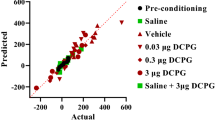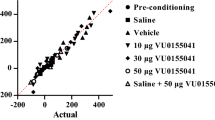Abstract
Rationale
A large body of evidence indicates an involvement of the mesolimbic dopamine (DA) pathway innervating the ventral striatum in the motivational effects of drug abuse.
Objective
The goal of the study is to clarify the role of DA D1 and D2 receptors of the rat nucleus accumbens (NAc) shell and core in the motivational effects of morphine as studied by conditioned place preference (CPP).
Methods
The effect of the intracerebral infusion of DA antagonists specific for DA D1 (SCH 39166) and D2 receptors (l-sulpiride) was studied in a single-trial place conditioning paradigm with fixed assignment of the drug to the unpreferred compartment.
Results
Morphine induced significant CPP at all the doses tested (0.5, 1.0, and 2.0 mg/kg, subcutaneously). A dose of 1.0 mg/kg was selected for further studies. Intra-NAc shell infusion of SCH 39166 and l-sulpiride at doses of 25 and 50 ng/1 μl per side impaired the acquisition of CPP by morphine. No effect was observed at 12.5 ng/1 μl per side. Intra-NAc core infusion of SCH 39166 (12.5, 25, and 50 ng/1 μl per side) did not affect the acquisition of morphine-induced CPP, while l-sulpiride (12.5, 25, and 50 ng/1 μl per side) impaired CPP acquisition only at the dose of 50 ng/1 μl per side. No effect on morphine-induced CPP was observed when the DA antagonists were infused into the NAc shell or core 10 min before the test session.
Conclusion
These results indicate that DA D1 and D2 receptors in the NAc shell are involved in the acquisition of morphine-induced CPP.




Similar content being viewed by others
References
Acquas E, Di Chiara G (1994) D1 receptor blockade stereo-specifically impairs the acquisition of drug-conditioned place preference and place aversion. Behav Pharmacol 5:555–569
Acquas E, Carboni E, Leone P, Di Chiara G (1989) SCH 23390 blocks drug-conditioned place-preference and place-aversion: anhedonia (lack of reward) or apathy (lack of motivation) after dopamine-receptor blockade? Psychopharmacology 99:151–155
Baker DA, Khroyan TV, O’Dell LE, Fuchs RA, Neisewander JL (1996) Differential effects of intra-accumbens sulpiride on cocaine-induced locomotion and conditioned place preference. J Pharmacol Exp Ther 279:392–401
Bardo MT, Neisewander JL (1986) Single-trial conditioned place preference using intravenous morphine. Pharmacol Biochem Behav 25:1101–1105
Bardo MT, Neisewander JL (1987) Chronic naltrexone supersensitizes the reinforcing and locomotor-activating effect of morphine. Pharmacol Biochem Behav 28:267–273
Bardo MT, Neisewander JL, Miller JS (1986) Repeated testing attenuates conditioned place preference with cocaine. Psychopharmacology 89:239–243
Bardo MT, Valone JM, Bevins RA (1999) Locomotion and conditioned place preference produced by acute intravenous amphetamine: role of dopamine receptors and individual differences in amphetamine self-administration. Psychopharmacology 143:39–46
Bardo MT, Gehrke BJ, Shortridge BE, Rauhut AS (2003) Effects of beta-funaltrexamine and naloxonazine on single-trial morphine-conditioned place preference and locomotor activity. Pharmacol Biochem Behav 74:617–622
Bechara A, van der Kooy D (1992) Chronic exposure to morphine does not alter the neural tissues subserving its acute rewarding properties; apparent tolerance is overshadowing. Behav Neurosci 106:364–373
Berridge KC, Robinson TE (1998) What is the role of dopamine in reward: hedonic impact, reward learning, or incentive salience? Brain Res Brain Res Rev 28:309–369
Bozarth MA, Wise RA (1981) Heroin reward is dependent on a dopaminergic substrate. Life Sci 29:1881–1886
Calcagnetti DJ, Schechter MD (1994) Nicotine place preference using the biased method of conditioning. Prog Neuropsychopharmacol Biol Psychiatry 18:925–933
Carboni E, Acquas E, Leone P, Di Chiara G (1989) 5HT3 receptor antagonists block morphine- and nicotine- but not amphetamine-induced reward. Psychopharmacology 97:175–178
Carr GD, Fibiger HC, Phillips AG (1989) Conditioned place preference as a measure of drug reward. In: Liebman JM, Cooper SJ (eds) Oxford reviews in psychopharmacology: neuropharmacological basis of reward. Oxford University Press, New York, pp 264–319
Chipkin RE, Iorio LC, Coffin VL, McQuade RD, Berger JG, Barnett A (1988) Pharmacological profile of SCH39166: a dopamine D1 selective benzonaphthazepine with potential antipsychotic activity. J Pharmacol Exp Ther 247:1093–1102
Cunningham CL, Ferree NK, Howard MA (2003) Apparatus bias and place conditioning with ethanol in mice. Psychopharmacology 170:409–422
Di Chiara G (1995) The role of dopamine in drug abuse viewed from the perspective of its role in motivation. Drug Alcohol Depend 38:95–137
Di Chiara G (1998) A motivational learning hypothesis of the role of dopamine in compulsive drug use. J Psychopharmacol 12:54–67
Di Chiara G (2000) Dopamine and reward. In: Di Chiara G (ed) Handbook of Experimental Pharmacology 154 ‘Dopamine in the CNS,’ vol. II. Springer, Berlin Heidelberg New York, 299–319
Di Chiara G (2002) Nucleus accumbens shell and core dopamine: differential role in behavior and addiction. Behav Brain Res 137:75–114
Di Chiara G, Imperato A (1988) Opposite effects of mu and kappa opiate agonists on dopamine release in the nucleus accumbens and in the dorsal caudate of freely moving rats. J Pharmacol Exp Ther 244:1067–1080
Di Chiara G, Morelli M, Consolo S (1994) Modulatory functions of neurotransmitters in the striatum: ACh/dopamine/NMDA interactions. Trends Neurosci 17:228–233
Di Chiara G, Bassareo V, Fenu S, De Luca MA, Spina L, Cadoni C, Acquas E, Carboni E, Valentini V, Lecca D (2004) Dopamine and drug addiction: the nucleus accumbens shell connection. Neuropharmacology 47:227–241
Dickinson A, Smith J, Mirenowicz J (2000) Dissociation of Pavlovian and instrumental incentive learning under dopamine antagonists. Behav Neurosci 114:468–483
Duffy RA, Hunt MA, Wamsley JK, McQuade RD (2000) In vivo autoradiography of [3H]SCH 39166 in rat brain: selective displacement by D1/D5 antagonists. J Chem Neuroanat 19:41–46
Ettenberg A (1990) Haloperidol prevents the reinstatement of amphetamine-rewarded runway responding in rats. Pharmacol Biochem Behav 36:635–638
Ettenberg A, McFarland K (2003) Effects of haloperidol on cue-induced autonomic and behavioral indices of heroin reward and motivation. Psychopharmacology 168:139–145
Fenu S, Bassareo V, Di Chiara G (2001) A role for dopamine D1 receptors of the nucleus accumbens shell in conditioned taste aversion learning. J Neurosci 21:6897–6904
Hoffman DC (1989) The use of place conditioning in studying the neuropharmacology of drug reinforcement. Brain Res Bull 23:373–387
Horvitz JC, Ettenberg A (1988) Haloperidol blocks the response-reinstating effects of food reward: a methodology for separating neuroleptic effects on reinforcement and motor processes. Pharmacol Biochem Behav 31:861–865
Horvitz JC, Ettenberg A (1991) Conditioned incentive properties of a food-paired conditioned stimulus remain intact during dopamine receptor blockade. Behav Neurosci 105:536–541
Ikemoto S, Glazier BS, Murphy JM, McBride WJ (1997) Role of dopamine D1 and D2 receptors in the nucleus accumbens in mediating reward. J Neurosci 17:8580–8587
Le Foll B, Goldberg SR (2005) Nicotine induces conditioned place preferences over a large range of doses in rats. Psychopharmacology 178:481–492
Leone P, Di Chiara G (1987) Blockade of D1 receptors by SCH 23390 antagonizes morphine and amphetamine induced place preference conditioning. Eur J Pharmacol 135:251–254
Liu ZH, Jin WQ, Zhang HP, Chen XJ, Jin GZ (2003) Suppression of morphine-induced place preference by l-12-chloroscoulerine, a novel dopamine receptor ligand. Pharmacol Biochem Behav 75:289–294
Mackey WB, van der Kooy D (1985) Neuroleptics block the positive reinforcing effects of amphetamine but not of morphine as measured by place conditioning. Pharmacol Biochem Behav 22:101–105
Maldonado R, Salardi A, Valverde O, Samad TA, Roques BP, Borrelli E (1997) Absence of opiate rewarding effects in mice lacking dopamine D2 receptors. Nature 388:586–589
Manzanedo C, Aguilar MA, Rodríguez-Arias M, Miñarro J (2001) Effects of dopamine antagonists with different receptor blockade profiles on morphine-induced place preference in male mice. Behav Brain Res 121:189–197
McFarland K, Ettenberg A (1995) Haloperidol differentially affects reinforcement and motivational processes in rats running an alley for intravenous heroin. Psychopharmacology 122:346–350
McFarland K, Ettenberg A (1998) Haloperidol does not affect motivational processes in an operant runway model of food-seeking behavior. Behav Neurosci 112:630–635
McFarland K, Ettenberg A (1999) Haloperidol does not attenuate conditioned place preferences or locomotor activation produced by food- or heroin-predictive discriminative cues. Pharmacol Biochem Behav 62:631–641
Mucha RF, van der Kooy D, O’Shaughnessy M, Bucenieks P (1982) Drug reinforcement studied by the use of place conditioning in rat. Brain Res 243:91–105
Paxinos G, Watson C (1998) The rat brain in stereotaxic coordinates. Academic, San Diego, USA
Phillips AG, Pfaus JG, Blaha CD (1991) Dopamine and motivated behavior: insights provided by in vivo analysis. In: Willner P, Scheel-Kruger J (eds) The mesolimbic dopamine system: from motivation to action. Wiley, Chichester, UK, pp 199–224
Pontieri FE, Tanda G, Di Chiara G (1995) Intravenous cocaine, morphine, and amphetamine preferentially increase extracellular dopamine in the “shell” as compared with the “core” of the rat nucleus accumbens. Proc Natl Acad Sci USA 92:12304–12308
Rezayof A, Zarrindast MR, Sahraei H, Haeri-Rohani A (2002) Involvement of dopamine D2 receptors of the central amygdala on the acquisition and expression of morphine-induce place preference in rat. Pharmacol Biochem Behav 74:187–197
Robbins TW (2005) Role of cortical and striatal dopamine in cognitive function. In: Dunnett SB, Bentivoglio M, Bjorklund A, Hokfelt T (eds) Dopamine, handbook of chemical neuroanatomy, vol. 21. Elsevier, Amsterdam, pp 395–434
Robbins TW, Cador M, Taylor JR, Everitt BJ (1989) Limbic–striatal interactions in reward-related processes. Neurosci Biobehav Rev 13:155–162
Salamone JD (1992) Complex motor and sensorimotor functions of striatal and accumbens dopamine: involvement in instrumental behavior processes. Psychopharmacology 107:160–174
Salamone JD, Cousins MS, Snyder BJ (1997) Behavioral functions of nucleus accumbens dopamine: empirical and conceptual problems with the anhedonia hypothesis. Neurosci Biobehav Rev 21:341–359
Schwartz AS, Marchok PL (1974) Depression of morphine-seeking behaviour by dopamine inhibition. Nature 248:257–258
Sellings LH, Clarke PB (2003) Segregation of amphetamine reward and locomotor stimulation between nucleus accumbens medial shell and core. J Neurosci 23:6295–6303
Shippenberg TS, Herz A (1987) Place preference conditioning reveals the involvement of D1 dopamine receptors in the motivational properties of μ- and κ-opioid agonists. Brain Res 436:169–172
Shippenberg TS, Herz A (1988) Motivational effects of opioids: influence of D1 versus D2 receptor antagonists. Eur J Pharmacol 151:233–242
Shippenberg TS, Bals-Kubik R, Huber A, Herz A (1991) Neuroanatomical substrates mediating the aversive effects of D-1 dopamine receptor antagonists. Psychopharmacology 103:209–214
Shippenberg TS, Bals-Kubik R, Herz A (1993) Examination of the neurochemical substrates mediating the motivational effects of opioid: role of mesolimbic dopamine system and D1 vs. D2 dopamine receptors. J Pharmacol Exp Ther 265:53–59
Smith JW, Fetsko LA, Xu R, Wang Y (2002) Dopamine D2L receptor knockout mice display deficits in positive and negative reinforcing properties of morphine and in avoidance learning. Neuroscience 113:755–765
Spina L, Fenu S, Longoni R, Rivas E, Di Chiara G (2006) Nicotine-conditioned single-trial place preference: selective role of nucleus accumbens shell dopamine D1 receptors in acquisition. Psychopharmacology 184(3–4):447–455
Spyraki C, Fibiger HC, Phillips AG (1983) Attenuation of heroine reward in rats by disruption of the mesolimbic dopamine system. Psychopharmacology 79:278–283
Suzuki T, Misawa M (1995) Sertindole antagonizes morphine-, cocaine- and methamphetamine-induced place preference in the rat. Life Sci 57:1277–1284
Suzuki T, Funada M, Narita M, Misawa M, Nagase H (1993) Morphine induced place preference in the CXBK mouse: characteristics of mu opioid receptor subtypes. Brain Res 602:45–52
Tzschentke TM (1998) Measuring reward with the conditioned place preference paradigm: a comprehensive review of drug effects, recent progress and new issues. Prog Neurobiol 56:613–672
Wise RA (1982) Neuroleptics and operant behaviour: the anhedonia hypothesis. Behav Brain Sci 5:39–87
Acknowledgements
This study was supported by funds from Ministero dell’Università e della Ricerca, Progetti di ricerca nazionale Bando 2003, and Centre of Excellence for Studies on Dependence, and from the European Commission, NIDE project.
Author information
Authors and Affiliations
Corresponding author
Rights and permissions
About this article
Cite this article
Fenu, S., Spina, L., Rivas, E. et al. Morphine-conditioned single-trial place preference: role of nucleus accumbens shell dopamine receptors in acquisition, but not expression. Psychopharmacology 187, 143–153 (2006). https://doi.org/10.1007/s00213-006-0415-2
Received:
Accepted:
Published:
Issue Date:
DOI: https://doi.org/10.1007/s00213-006-0415-2




